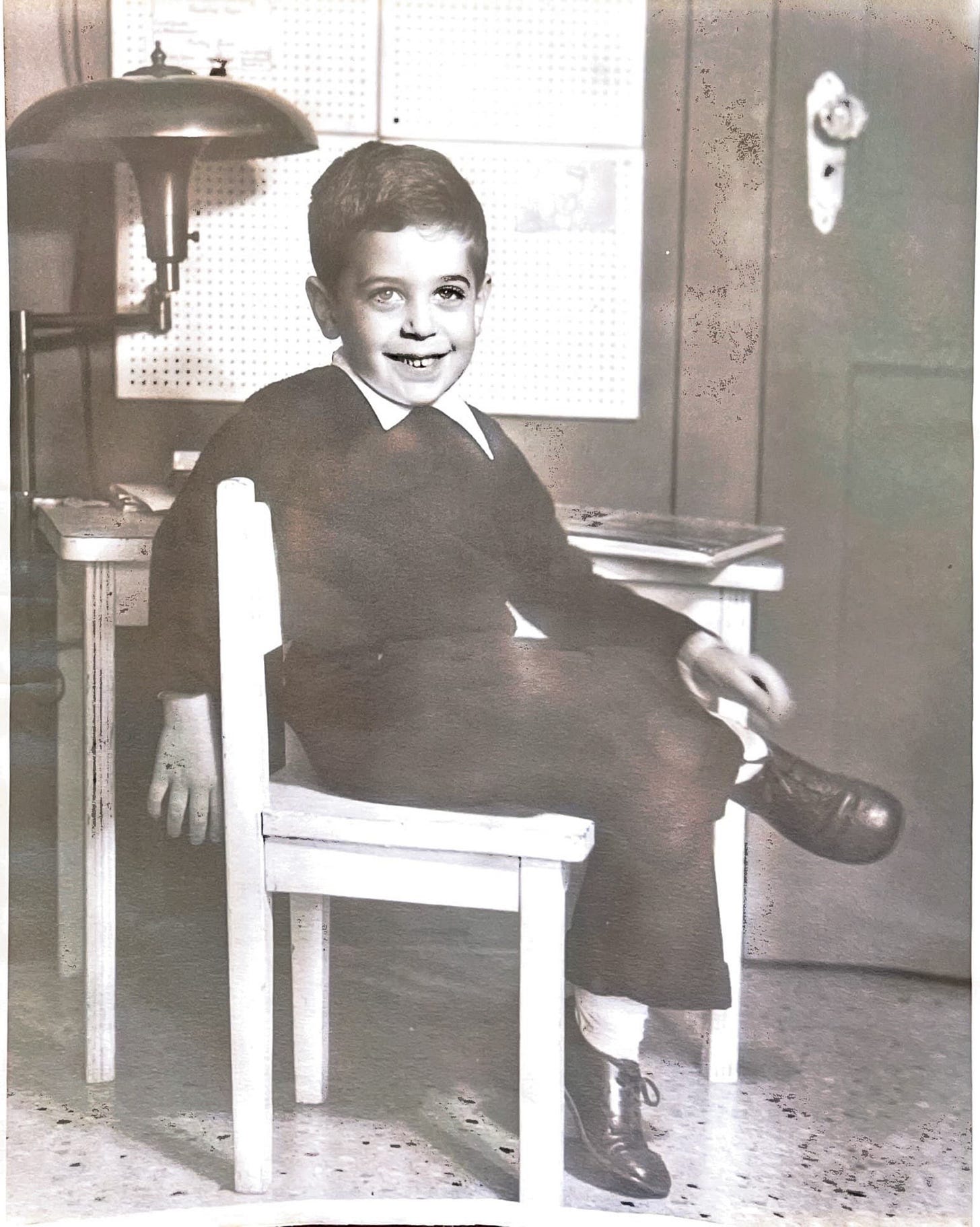We asked Robert Reich to share his advice on learning to use his writing and drawing skills to illustrate his Substack. Read on for Robert’s advice, or listen to him read it aloud above.
Dear writer, how do you make your newsletter unique? How do you make sure your personality shines through?
Dear writer,
This feels presumptuous. What could I possibly tell you about bringing your unique personality to your work when I’m still struggling (after more than sixty-five years of writing) to do this? And why would anyone suppose that there are any useful general principles when it’s all about uniqueness?
Bear with me a moment.
I’ve been drawing and writing ever since I remember—the two have always gone together. Here’s an early photo of me (circa 1952) after a hard day writing and drawing.
That notebook on my desk is my first illustrated book. It was entitled “The Adventures of Itchy the Mosquito” and had a print run of one.
It’s always been easier for me to write and draw than to do one or the other separately. Words and images seem to flow in and from my brain at the same time.
When I say “draw,” I don’t mean anything more elaborate than a sketch or cartoon. I doodled my way through elementary school—drawing everyone from teachers and friends, anything I glimpsed out the classroom window, and just about any idea that floated into my head.
As a teenager, I came across a copy of the New Yorker and was delighted to find cartoons on the same pages as serious print content. Those pages showed me the subtle interplay between drawings and the written word: no matter how heavy or intense the article, the cartoons added a bounce that somehow made the articles easier to read. (At age 15 I began to submit articles and cartoons to the New Yorker and soon accumulated enough rejection slips to paper a wall of my bedroom with them.)
I also loved books and stories by James Thurber and by E.B. White, both of whom combined great writing with lively cartoonish drawing.
So maybe that’s part of what I can suggest to you: go with what you’ve been trying to do for as long as you remember. Don’t worry about whether it’s great writing—or even whether it’s writing at all. It’s you, and it tickles you—and that’s enough.
As an adult, I’ve rarely had a chance to put drawing and writing together, although my book publisher did let me illustrate the paperback version of Beyond Outrage, and a graphic publisher put out a collection of my drawings called Economics in Wonderland. Since co-founding Inequality Media, I’ve done a number of videos in which I speak and draw.
But not until Substack have I found such a natural place to combine writing and drawing. And Substack’s formatting makes it easy to slot cartoon images in seamlessly between paragraphs. Here’s a drawing I did for a post about the tyranny of stuff.
And one for the caption contest I hold weekly. (The winning caption for this one: “You know what your problem is? You worry about every little thing.”)
I’m also experimenting with the podcast feature on Substack, because it offers another way to connect with subscribers—and a kind of intimacy I can’t always achieve in writing and drawing. Sometimes I’ll record a podcast without any writing; sometimes the podcast will be a short summary of the writing; sometimes I’ll try for interplay between writing, drawing, and speaking.
The point is to bring your personality to your Substack—reaching out to subscribers (and potential subscribers) just as you reach out to friends (and potential friends), with the full range of ways you connect.
For writers interested in the nuts and bolts of illustrating, let me take you a bit more through my process.
Not until Substack have I found such a natural place to combine writing and drawing.
Generally, I start with a pencil sketch, on thick paper. Then I ink it in with a thin Sharpie, and add a thicker Sharpie for emphasis. Then comes the color. I like bright colors with the look and feel of watercolor, and have found Copic sketch pens ideal.
Most drawings take very little time. They really are sketches. If they become too complicated or realistic, they pull attention away from the text.
I rarely begin with an essay or drawing that’s nearly finished in my head. Instead, I let thoughts bubble up—loose and ill-formed at first, both verbally and visually. Something or someone has made me angry, or curious, or provoked a memory, but I don’t know exactly what or who until I start sketching with words and images. Maybe I draw a path leading to quicksand, and then see democracy moving toward where it’s in danger of being swallowed up—and ask myself exactly why (big money?) and what can be done to prevent it. Or I begin writing about something in the news that catches my attention—say, a strike by Amazon warehouse workers—and start drawing Jeff Bezos sitting on a pile of money, situated on top of…Amazon workers.
I especially enjoy sketching people who infuriate me—Tucker Carlson, Trump, Mitch McConnell, Elon Musk—because the cartoon portrayals allow me to exaggerate aspects of them that illustrate their character (Carlson’s fake furrowed brow, Trump’s vapid smile, McConnell’s double chins, Musk’s impetuous grin).
See more: My year in cartoons
I sketch at the same table where my laptop sits, so that I can refer back to what I’ve written and draw from it (literally and figuratively). My laptop, sketch book, Sharpies and Copic pens take up just about all the space on the table—not unlike the little table I started at sixty-odd years ago, where I produced “The Adventures of Itchy the Mosquito.”
Hope this was helpful.
All best,
Robert Reich
This is the sixth in a recurring series of longform writer advice, following Helena Fitzgerald’s advice on isolation, Alicia Kennedy’s advice on learning to listen, Embedded’s Kate Lindsay’s advice on creating trust with your readers, Lance’s Anna Codrea-Rado’s advice on learning to celebrate just how far you’ve come, and Mason Currey’s advice on creative growth.
Could you use some advice or inspiration from a fellow writer about creativity, motivation, and the writing life? Submit your question for consideration for a future advice column by leaving it in the comments below.





















